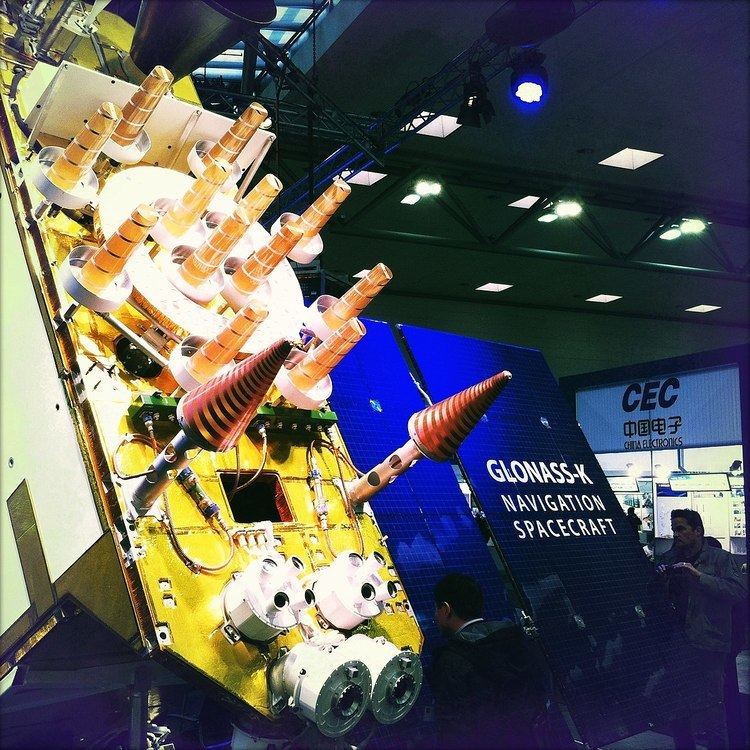Manufacturer ISS Reshetnev Applications Navigation Design life 10 years | Country of origin Russia | |
 | ||
Operator JSC «Navigation-Information systems» | ||
GLONASS-K is the latest satellite design intended as a part of the Russian GLONASS radio-based satellite navigation system. Developed by ISS Reshetnev (Reshetnev Information Satellite Systems) and first launched on 26 February 2011, it is a substantial improvement of the previous GLONASS-M second-generation satellites, having a longer lifespan and better accuracy.
Contents
History
The Federal Targeted Program "Global Navigation System" 2002–2011, introduced in 2001, stipulated the development of a third-generation navigation satellite design, called GLONASS-K, as part of the overall GLONASS upgrade program in the time frame 2005–2011. The new satellite followed the second generation GLONASS-M, introduced in 2003. The Russian Federal Space Agency (Roscosmos) initially ordered 27 GLONASS-K satellites from ISS Reshetnev, the developer of all the previous GLONASS satellites. On 7 December 2010, the company announced it had completed ground tests of the first GLONASS-K satellite. The satellite was launched to orbit on 26 February 2011. On November 30, 2014, the second and supposedly last GLONASS-K1 development satellite was put to orbit as Kosmos 2501.
On a May 28, 2014, interview, Nikolay Testoyedov — president of ISS Reshetnev — stated that production of GLONASS-M would end in 2015, with GLONASS-K being exclusively produced after that final batch. In an December 14, 2014, interview with GPS World, he stated that because of Western sanctions that limited the supply of radiation resistant electronics, they had decided to launch nine additional GLONASS-K1 as fleet replacement while they finished the GLONASS-K2 design. In a May 2015 presentation, Mr. Testoyedov expected the serial production of GLONASS-K1 to start flying in early 2018, just after the launch of the first GLONASS-K2 prototype. The presentation showed at least eleven additional GLONASS-K1 satellites flying until 2020.
Satellites
GLONASS-K is the first unpressurised GLONASS satellite—all of its equipments are able to operate in a vacuum. Due to this, the satellite's mass has been substantially reduced: GLONASS-K has a mass of just 935 kg compared to its predecessor GLONASS-M, which had a mass of 1,450 kg. The new satellite has an operational lifetime of 10 years, three years longer than that of GLONASS-M and seven years longer than the lifetime of the original GLONASS satellite. It also increased the power supply from GLONASS-M's 1,400 W to 1,600 W.
GLONASS-K will transmit additional navigation signals to improve the system's accuracy. Existing FDMA signals, 2 military and 2 civilian, will be transmitted on the L1 and L2 bands, and additional civilian CDMA signals will be transmitted in the L1, L2, L3 and L5 bands.
Launches
For launching the satellites, two options are planned: six satellites simultaneously from Baikonur Cosmodrome on the heavy-lift Proton-M, or two simultaneously from Plesetsk Cosmodrome on a Soyuz-2 with a Fregat upper stage. In comparison, the previous GLONASS-M satellites could only be launched three at a time on a Proton-M. The new launch scheme is expected to cut orbiting costs by 50%. The new satellite's advanced equipment —made solely from Russian components— was expected to allow doubling the accuracy. The launch of the first GLONASS-K satellite did however not conform to the general plan, as it was launched alone on a Soyuz-2.1b instead of in a pair.
At 06:07 Moscow Time on 26 February 2011, the first GLONASS-K satellite, Kosmos 2471, was launched. The launch took place from Plesetsk Cosmodrome on a Soyuz-2.1b rocket with a Fregat upper stage. The satellite reached the correct orbit at 09:39. At 09:44, ground stations established control over the satellite. A Space Forces spokesman told Interfax: "we have established and are maintaining steady telemetry communications with the spacecraft... the on-board systems of the Glonass-K satellite are functioning normally." Successful reception of the CDMA signal in L3 band has been reported by independent researchers.
At 21:52:26 UTC on 30 November 2014, the second GLONASS-K satellite, Kosmos 2501 was launched. The launch took place from Plesetsk Cosmodrome on a Soyuz-2.1b rocket with a Fregat upper stage. The spacecraft separated from the launch vehicle at 01:25 UTC of 1 December.
Photogallery from CeBIT 2011 in Hannover
Russia has exhibited the Glonass-K spacecraft during the CeBIT 2011 fair, that took place in Hannover from 1st to 5 March.
